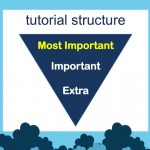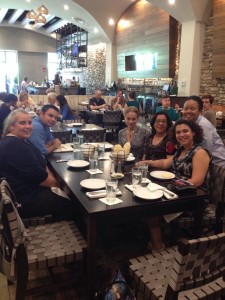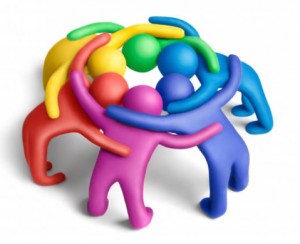A Blended Librarians Online Learning Community Webcast, September 18, 2014
 Presented by Nichole Martin and Ross Martin, Librarians at Seminole State College of Florida
Presented by Nichole Martin and Ross Martin, Librarians at Seminole State College of Florida
Dawn Cadogan, Jennifer Lanzing, and myself, members of the new Pedagogy and Learning Objects Workgroup, gathered to participate in a webinar on web tutorial creation offered by Blended Librarians titled : Would you watch it? Creating Effective & Engaging Video Tutorials. The presenters, librarians at Seminole State College of Florida, have a very large contingent of distance programs to support. They have extensively studied online video production and presented on all aspects they have learned and employed to produce the most effective and engaging videos. Their presentation was concise and full of lessons learned.
Types of video tutorials they have used
Screencasts: captures your computer screen, mouse motions, may include audio. Research shows that students respond well to this type of tutorial. They are very effective for novice learners in providing quick increase in skills. High achieving students use these for review and reinforcement
- Jing or screenr : used for “quick and dirty”, informal, perhaps even one time use. Hosted only by the product.
- Camtasia and Captivate: more enduring, better quality, more options for formats and hosts.
Slidecasts: not much research has been done on this type of learning
- PowerPoint can be saved as mp4. Can be saved to your own YouTube and Vimeo.
- Captivate: high quality, several options for saving. This is their favorite platform for video creation. Saving options, format options, multiple choices.
Live Action: tells an authentic story, relevant to the student who can see themselves needing to complete this task
- Window Live Movie Maker, as an example. Needs an authentic storyline, an actor (does not need to be a librarian, students may be even better), just need a pleasant personality, likeable.
Animation: fun and informal, research shows they may be easier to get across difficult concepts, more visceral and verbal response by the viewer, if you use your own avatar then you won’t need to worry about having s “bad hair day” (per presenters J )
- Go Animate
- Powtoons
- Adobe Flash:big learning curve but you make your own animations.
Interactive Tutorials: research shows these are the best way to reach all learning styles, gives greater control to users who can stop, start, repeat as needed, allows for real time assessments with interactions. Can be combined with screencasts and other types of video.
- Adobe Flash
- Captivate
- Storyline
Here are some of their best tips for creating and working with videos:
Resource based or Content focused?
Choosing to create a video on a particular resource, like Summon, for example, will require editing each time the resource changes – or in the case of Summon, disappears. They go out of date sooner than content based videos. There are times when a resource tutorial is essential. Be sure to save all iterations of the written transcript for each tutorial. This saves time in the event of interfaces changes when new screen shots are the biggest difference.
Concept based tutorials are more difficult to capture but have a longer shelf life. Topics such as “How to create a search question” or “How to develop a list of keywords” are longer lasting and widely applicable.
Length
No longer than 3 minutes! 2 minutes may be better. Research shows that people generally watch only half of any YouTube video. In the creation of their videos, the presenters admit that it takes from 1 – 3 hours to create 1 minute of good quality video. And they are good at it!
Viewer Retention
At Seminole, they have increased their viewer retention from about 30% of the video when they first started producing online tutorials to over 50% by changing their format to a journalism type structure.
Thinking of a news article, put the most important item right up front, follow it by the next important, and end with any filler. They got rid of all introductions and started right off with the main point.
Quality Audio
Extremely important for viewer retention. Use a good quality microphone, reduce ambient noise, have a pleasing tone of voice.
Closed Captioning (Accessibility)
YouTube has the most features for closed captioning but make sure you edit the texts. Vimeo does not have as much user control. In YouTube, CC can be on or off controlled by the user. Research shows that simultaneous text and sound are too much information for the viewer. Make the CC optional.
There are many more tips and recommendations in this very informative presentation. Please use the links below to view the webcast and to see examples of their videos.
Watch this Blended Librarian Webcast here:
https://sas.elluminate.com/p.jnlp?psid=2014-09-18.1211.M.3D85CAA9C5C3E5884DE0B675E37E71.vcr&sid=75
Seminole State Library YouTube Channel: https://www.youtube.com/channel/UC7uq_9realinCgGPa5l5_Zg




